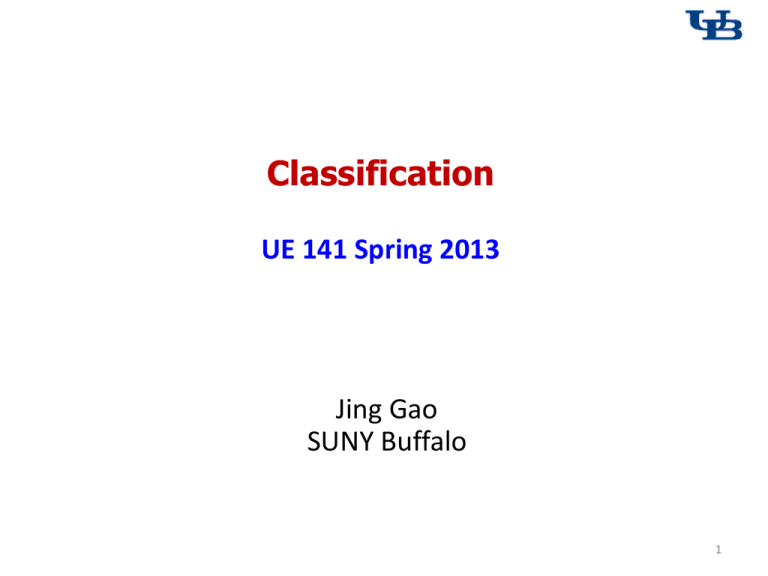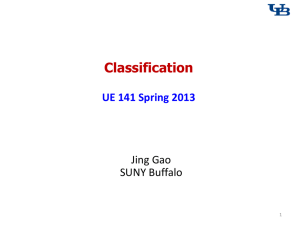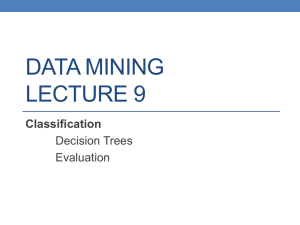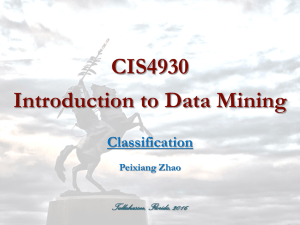Classification UE 141 Spring 2013 Jing Gao
advertisement

Classification UE 141 Spring 2013 Jing Gao SUNY Buffalo 1 Classification features patient class labels temp. blood pres. heart rate Sick? 99 110 90 Yes 100 120 100 Yes 96 130 65 No labeled training a model: f(x)=y: features class labels patient temp. blood pres. heart rate Sick? 98 130 80 115 110 95 test unlabeled 2 Illustrating Classification Task Tid Attrib1 1 Yes Large 125K No 2 No Medium 100K No 3 No Small 70K No 4 Yes Medium 120K No 5 No Large 95K Yes 6 No Medium 60K No 7 Yes Large 220K No 8 No Small 85K Yes 9 No Medium 75K No 10 No Small 90K Yes Attrib2 Attrib3 Class Learning algorithm Induction Learn Model Model 10 Training Set Tid Attrib1 Attrib2 Attrib3 11 No Small 55K ? 12 Yes Medium 80K ? 13 Yes Large 110K ? 14 No Small 95K ? 15 No Large 67K ? Apply Model Class Deduction 10 Test Set 3 Classification Techniques • • • • • • • Decision Tree Naïve Bayes Logistic Regression Support Vector Machines K nearest neighbor Ensemble learning …… 4 Example of a Decision Tree Tid Refund Marital Status Taxable Income Cheat 1 Yes Single 125K No 2 No Married 100K No 3 No Single 70K No 4 Yes Married 120K No 5 No Divorced 95K Yes 6 No Married No 7 Yes Divorced 220K No 8 No Single 85K Yes 9 No Married 75K No 10 No Single 90K Yes 60K Splitting Attributes Refund Yes No NO MarSt Single, Divorced TaxInc < 80K NO Married NO > 80K YES 10 Training Data Model: Decision Tree 5 Another Example of Decision Tree MarSt Tid Refund Marital Status Taxable Income Cheat 1 Yes Single 125K No 2 No Married 100K No 3 No Single 70K No 4 Yes Married 120K No 5 No Divorced 95K Yes 6 No Married No 7 Yes Divorced 220K No 8 No Single 85K Yes 9 No Married 75K No 10 No Single 90K Yes 60K Married NO Single, Divorced Refund No Yes NO TaxInc < 80K NO > 80K YES There could be more than one tree that fits the same data! 10 6 Apply Model to Test Data Test Data Start from the root of tree. Refund Yes Refund Marital Status Taxable Income Cheat No 80K Married ? 10 No NO MarSt Single, Divorced TaxInc < 80K NO Married NO > 80K YES 7 Apply Model to Test Data Test Data Refund Yes Refund Marital Status Taxable Income Cheat No 80K Married ? 10 No NO MarSt Single, Divorced TaxInc < 80K NO Married NO > 80K YES 8 Apply Model to Test Data Test Data Refund Yes Refund Marital Status Taxable Income Cheat No 80K Married ? 10 No NO MarSt Single, Divorced TaxInc < 80K NO Married NO > 80K YES 9 Apply Model to Test Data Test Data Refund Yes Refund Marital Status Taxable Income Cheat No 80K Married ? 10 No NO MarSt Single, Divorced TaxInc < 80K NO Married NO > 80K YES 10 Apply Model to Test Data Test Data Refund Yes Refund Marital Status Taxable Income Cheat No 80K Married ? 10 No NO MarSt Single, Divorced TaxInc < 80K NO Married NO > 80K YES 11 Apply Model to Test Data Test Data Refund Yes Refund Marital Status Taxable Income Cheat No 80K Married ? 10 No NO MarSt Single, Divorced TaxInc < 80K NO Married Assign Cheat to “No” NO > 80K YES 12 Build a Decision Tree • Let Dt be the set of training records that reach a node t Tid Refund Marital Status Taxable Income Cheat 1 Yes Single 125K No • General Procedure: 2 No Married 100K No 3 No Single 70K No 4 Yes Married 120K No 5 No Divorced 95K Yes 6 No Married No 7 Yes Divorced 220K No 8 No Single 85K Yes 9 No Married 75K No 10 No Single 90K Yes – If Dt contains records that belong the same class yt, then t is a leaf node labeled as yt – If Dt contains records that belong to more than one class, use an attribute to split the data into smaller subsets. Recursively apply the procedure to each subset 60K 10 Dt ? 13 Example Refund Yes No Don’t Cheat Refund Refund Yes No Don’t Marital Cheat Status Single, Married Divorced Don’t Cheat Yes No Tid Refund Marital Status Taxable Income Cheat 1 Yes Single 125K No 2 No Married 100K No 3 No Single 70K No 4 Yes Married 120K No 5 No Divorced 95K Yes 6 No Married No 7 Yes Divorced 220K No 8 No Single 85K Yes 9 No Married 75K No No Single 90K Yes Don’t Marital 10 Cheat Status Single, Married Divorced Don’t Taxable Cheat Income 60K 10 < 80K Don’t Cheat >= 80K Cheat 14 How to determine the Best Split Before Splitting: 10 records of class 0, 10 records of class 1 OnCampus? Yes No Car Type? Family Student ID? Luxury c1 c10 Sports C0: 6 C1: 4 C0: 4 C1: 6 C0: 1 C1: 3 C0: 8 C1: 0 c20 C0: 1 C1: 7 C0: 1 C1: 0 ... C0: 1 C1: 0 c11 C0: 0 C1: 1 ... C0: 0 C1: 1 Which test condition is the best? 15 training patient Classification in Experiments temp. blood pres. heart rate Sick? 99 110 90 Yes 100 120 100 Yes 96 130 65 No test patient temp. blood pres. heart rate 98 130 80 Sick? 115 Yes (predicted) Yes (true) 110 95 Yes(predicted) No (true) 16 Metrics for Performance Evaluation # correct predictions Accuracy # total predictions Example. The test set includes 100 examples. When we use the model to predict the class labels of 100 examples, 90 of them are the same as the true labels, and 10 make mistakes. Then the accuracy of this model is 90%. 17 k-fold Cross Validation Partition the data set into k disjoint subsets. Each time use k-1 subsets as training, and the remaining 1 as test. Repeat this process k times and calculate the average classification accuracy. 90.2% 88.7% 85.4% 95.3% 90.7% 90.06% Typically k=10—10-fold cross validation 18 Lazy vs. Eager Learning • Lazy vs. eager learning – Lazy learning: Simply stores training data and waits until it is given a test record (one-step) – Eager learning: Given a set of training records, constructs a classification model before predicting on test data (two-step) • Comparison – The prediction phase of eager learning is usually short and most of the time is spent on training, instead, lazy learning does not have a training phase, but prediction time is long – Lazy learning focuses on “local” behavior while eager learning builds a “global” model 19 Nearest Neighbor Classifiers • Store the training records Set of Stored Cases Atr1 ……... AtrN Class A B B • Use training records to predict the class label of unseen cases Unseen Case Atr1 ……... AtrN C A C B 20 Nearest-Neighbor Classifiers Unknown record Requires three things – The set of stored records – Distance Metric to compute distance between records – The value of k, the number of nearest neighbors to retrieve To classify an unknown record: – Compute distance to other training records – Identify k nearest neighbors – Use class labels of nearest neighbors to determine the class label of unknown record (e.g., by taking majority vote) 21 Definition of Nearest Neighbor X (a) 1-nearest neighbor X X (b) 2-nearest neighbor (c) 3-nearest neighbor K-nearest neighbors of a record x are data points that have the k smallest distance to x 22 Nearest Neighbor Classification • Choosing the value of k: – If k is too small, sensitive to noise points – If k is too large, neighborhood may include points from other classes X 23 Question • Data mining tasks are not independent. For example, we can use association analysis to conduct classification. – The question is: How can we do that? – The topic is called rule-based classification. 24






